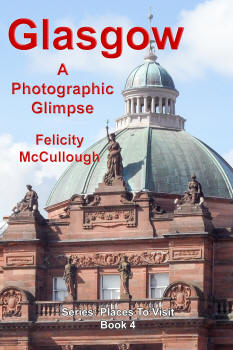Glasgow Green
Situated in the East End of Glasgow City, Glasgow Green is its oldest city park.
It was established in 1450 under a Grant of Land to Bishop William Turnbull and the people of Glasgow, by King James II.

King James II
Copyright
Early on, this marshland was used for grazing livestock, washing and bleaching linen and for the drying of fishing nets.
More gruesomely, the Green has been used for hangings. In front of a crowd of some 20,000 people, James Wilson, the Scottish Revolutionary, after being convicted of insurrection and treason, was hanged and beheaded on Glasgow Green, in 1822.
After more land was added in the early 1800s, the land was drained and levelled.
It is surprising that it remains as a Park, as many have tried and failed to deploy its natural resources and thwart its thoroughfare and public use.
After the Napoleonic Wars, surplus labour was deployed to remodel the Green.
Over the centuries, the Green has been used as a gathering place for many meetings, demonstrations and rallies, in order to stir up support for social causes, attracting large crowds.
In modern times, it is a popular venue where large outdoor sporting, music and other events are held on the Green.
Glasgow Green Railway Station
A railway station was opened 1 November 1895 and closed in the 1953. The Station building has since been demolished.
Nelson’s Monument

Obelisk Nelson's Monument
Felicity McCullough Copyright 2013
Sited in the Park is the first monument to the victories of Admiral Horatio Nelson. The 43.5 metre obelisk was erected in 1806, soon after the death of Nelson, on the Green.
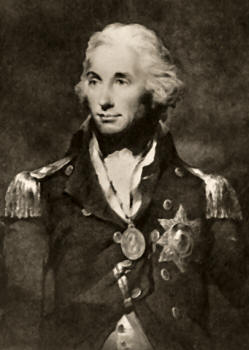
Nelson as Rear-Admiral, 1797
Copyright
It stands prominently behind the People’s Palace.
The obelisk has been struck by lightning, which caused the top to collapse. Now it is floodlit, after having been restored in 2002, at a cost of £900,000.
St. Andrew's Suspension Bridge
Built circa 1855 the St. Andrew's Suspension Bridge, traverses the River Clyde. It has been refurbished in the late 1990s, with partial funding from the European Union.
Templeton Carpet Factory
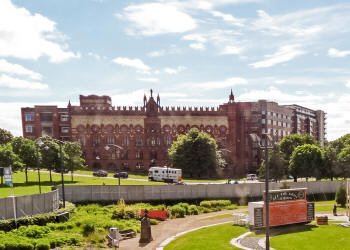
Templeton Carpet Factory
Felicity McCullough Copyright 2013
Designed by William Leiper and inspired by the Doge's Palace in Venice, this striking building cannot be missed. It is now the Templeton Business Centre, after having been refurbished in 2005.
Sir William Collins Drinking Fountain
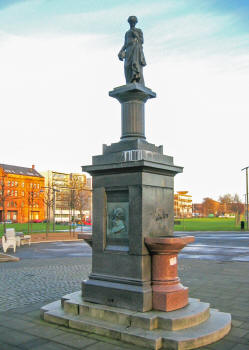
Sir William Collins Drinking Fountain
Copyright:
Alistair McMillan
Between 1877 and 1880, William Collins was the Lord Provost of Glasgow and leading advocate in the Temperance Movement. He is interned in Glasgow’s Necropolis.
Collins was knighted in 1880 and help build and make a success of the renowned Collins publishing firm.
A fountain and female statue was erected on Glasgow Green in tribute for his service to the Temperance Movement, by temperance reformers in 1881.
A bronze portrait medallion of Sir William Collins adorns one of the sides of the pink and grey granite pedestal, together with a plaque and drinking fountains on the other three sides.
The Fountain’s inscription:-
“Erected by Temperance Reformers in Recognition of Valuable Services Rendered to the Temperance Cause by Sir William Collins Lord Provost of the City of Glasgow 1877 – 1880 29th October 1881”
At the apex is a bronze statue of a
girl, sculpted by John G Mossman who is gazing at a flower and holding
an upturned pitcher. She represents the ethos of Temperance.
The.
In the early 1990s the fountain was moved near to the McLennan Arch.
McLennan Arch
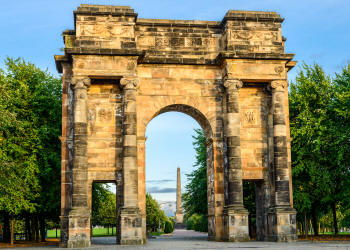
McLennan Arch With Nelson's Monument Obelisk
Copyright:
Matthi
The Arch was named after the Member of Parliament, Baillie James McLennan, who preserved and presented the Arch to the City of Glasgow.
The arch is dated 1843 and began life as the centrepiece and facade of the Assembly Rooms in Ingram Street.
The Assembly rooms were classically designed by leading Scottish architects Robert and James Adams.
The Rooms were known for social gathering, dancing, music performances and other cultural pursuits.
In 1892 the Assembly Rooms, then known as the Athenaeum, were demolished. The central arch facade was preserved and was reconstructed as an entrance to Glasgow Green, at the junction of Greendyke Street and Monteith Row.
The wide central opening arch is surrounded by four tall Ionic columns, reconstructed from the windowed façade of the former Assembly Rooms.
Above the smaller openings are two sculptural panels, which illustrate Apollo playing the Lyre. Also, the three Graces figures, appear to be dancing to a tambourine.
Next the Arch was moved to the end of Charlotte Street entrance to the Green, where it became unstable. Consequently, the Arch was further relocated to the Western Saltmarket entrance to Glasgow Green, facing the High Court of Justiciary’s building, where it stands majestically today.
Clyde Walkway
The cycle route also runs through Glasgow Green, known as the Clyde Walkway.
Tidal Weir
The Green, originally marshland, needed regulation of the Clyde’s water flow.
In 1901 Glasgow Corporation constructed a tidal weir, which is now a listed building.
The weir is designed, so that it creates two distinct ecosystems, side by side, one containing salt water and the other fresh water. The weir has resulted in the ability to maintain the water level of the Clyde, as it runs through the Green.
St Alphonsus Church
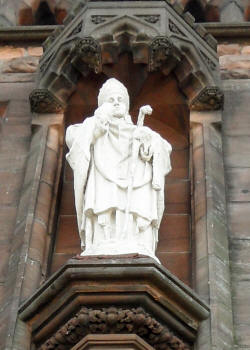
Saint Alphonsus Statue
Felicity McCullough Copyright 2013
St Alphonsus Church is in close proximity to Glasgow Green. It is located in one of the oldest parts of Glasgow. Interestingly it is the only Church in Scotland dedicated to St. Alphonsus.
The church was established in 1846 and the current building dates from 1905.
The building was designed by Peter Paul Pugin in a Neo-Gothic style, with much polished wood in the interior.
St. Alphonsus de Liguori, an Italian, was born in Naples in 1696. He was known for preaching among the poor. Also he founded the Redemptorists Religious Sect.
Summary of Visit
There was much fascination for me to see and do during my visit to Glasgow Green.
The approach to the People’s Palace also had some interesting shops and buildings of architectural interest. In particular, the Templeton Building held by attention.
Whilst there the Green was being prepared for a major event, so I wasn’t able to explore the outdoor areas, as much as I would have liked.
Combined with the People’s Palace and the Doulton Fountain, Glasgow would be a priority return visit, when I am next in Glasgow.
Glasgow has much to offer, see and do. Glasgow Green allows you to wander, relax and enjoy the large green spaces. If you want a dose of history this is also on hand. My book, ‘Glasgow A Photographic Glimpse’ was written to help plan your visit to Glasgow and to learn about some of the history in advance. The book is available by clicking the buy button below or is available from good book stores.
Felicity McCullough
 |
 |
 |
|
 |
 |
 |
|
 |
 |
 |
|
 |
 |
 |
|
 |
King James II
George Arents Collection, The New York Public Library. "King James II."
The New York Public Library Digital Collections
Nelson as Rear-Admiral, 1797
George Arents Collection, The New York Public Library. "Nelson as
rear-admiral, 1797." The New York Public Library Digital
Collections.
Sir William Collins Drinking Fountain
Copyright:
Alistair McMillan
McLennan Arch With Nelson's Monument
Obelisk
Copyright: Matthi
Articles: -
Links
Park Glasgow, Glasgow Green, Glasgow, Doulton fountain, Doulton fountain Glasgow, Doulton fountain Glasgow green, fountain in the green, glagow green, Glasgow green, Glasgow green gig, Glasgow green Glasgow, Glasgow green park, Glasgow green Scotland, Glasgow greens, Glasgow on the green, Glasgow saltmarket, glasgowgreen, green city Glasgow, green Glasgow, green park Glasgow, greens Glasgow, nice parks in Glasgow, parks in Glasgow for kids, parks near Glasgow, peoples palace Glasgow green, pretty green Glasgow, saltmarket Glasgow, the green Glasgow, the view Glasgow green, winter gardens Glasgow green,

